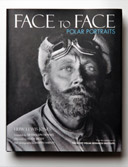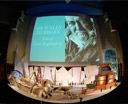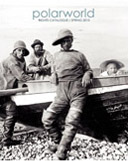 Our ProductsOur Resources |
This website requires the free Flash plugin to be installed.
Polarworld - discover more polar booksThe Arctic Book Review
Penny Russell Reviewed by Russell A. Potter "Lady Franklin arrived here today on her way from Melbourne to Sydney. A long dray drawn by four strong horses, containing her paraphernalia, led the van; next, a cart well filled with domestics, two or three sportsmen, two mounted police troopers, and last though not least, Her Ladyship, on horseback, accompanied by a Gentleman on either side, safely – I should hope – though not very speedily mounted." – An eyewitness, quoted in the Sydney Herald, 1839. Lady Jane Franklin Née Griffin, was in fact more far more widely travelled than her illustrious husband, the famously lost Sir John. She had always had a bit of a peripatetic turn, and her travels only extended further during her marriage, and the long years of uncertain widowhood which followed it. Of course, as the passage quoted makes clear, travelling for a proper Victorian lady was something quite different than a mere tramp among the hills with dog and camera, and Lady Franklin was, by those standards, travelling light. Nevertheless, there was a certain inevitably picaresque aspect to the journey described in this book, an aspect only enhanced by the details. Tobias Smollett himself could have given her Ladyship no more aptly-named servants than Mr. and Mrs. Snachall, nor a more lively and knowledgeable guide than the indefatigable Dr. Hobson, nor more singularly named stopping-places than the Murrumbidgee River, Yass, and the Illawarra district. Lady Franklin's journeys have been the subject of books before -- most notably, in two volumes, based on the journals of her longtime fellow-traveller Sophia Cracroft, detailing their visits to Victoria, British Columbia, and Sitka, Alaska. This Errant Lady, however, marks the first time that any of Lady Franklin's own journals have been published in anything approaching complete form, and indeed is the first book ever to give us a sustained look into the life of this remarkable woman. She could, by turns, be effusive, cold, ebullient, judgmental, affable, and withdrawn – sometimes all in the same day. Yet at the same time, she was a person of remarkable perseverance, who quite often deliberately ventured precisely to those places which all the well-meaning advice she received (and she received plenty) urged her to avoid. Once given, her friendship was absolute, and so too was her love for her sometimes-befuddled husband; thanks to the inclusion of numerous personal letters, interspersed at judicious intervals by Penny Russell, we gain much additional insight into her views of persons and places visited along with a keen sense of the love and trust she placed in Sir John. The style of the journal itself is richly detailed yet succinct, governed by a habitual mental shorthand in which Lady Franklin quickly jotted down the principal persons, places, and events as they were encountered. Yet thanks to the inclusion of the letters, as well as the comprehensive notes and apparatus provided by Ms. Russell, we get a remarkably lucid and detailed account of nearly every aspect of her journey. For the first leg of her trip, Lady Franklin enjoyed the company of Dr.Edmund Hobson, an energetic young physician and naturalist whose indefatigable good humor was matched by his skill as a hunter and guide. Lady Franklin was so impressed by this young man that she later urged her husband to find a Government position for him in Tasmania, where he was indeed appointed as Secretary of the Board of Education – one of several appointments which, rightly or wrongly, were seen by some as evidence of Lady Jane's undue influence. Yet as they ambled along the road from Melbourne to Goulburn River, such political doings seemed – and indeed were – quite distant. Most of the country through which the party passed was in some degree settled, and it was a rare night when they could not count on the hospitality of some local farmer or magnate. Their visits included tours of anything the local residents deemed remarkable, principally local feats of engineering (wells, irrigation ditches, earthenworks), civic buildings (orphanages, courthouses, and lunatic asylums), and farms. Not all of these buildings were properly complete; in one notable instance, Her Ladyship and guests dined in the rain within the walls of an as-yet roofless police station. One gets the impression – and no doubt it was the one intended – of Australia in this period as a thriving, bustling country, filled with new farms, new towns, and an entrepreneurial spirit. Yet there are, at the same time, many signs that not everyone was thriving equally; the Aboriginal inhabitants are mostly left out of the narrative, and when mentioned at all, are spoken of with disdain and fear. Many of the white settlers themselves were of course paroled prisoners, and yet the prisons in their new country were as inhumane, if not more so, than those from which they had fled. Civic pride and civil envy are also close twins, and Lady Franklin frequently found herself the object of competing factions, asking her to subscribe to this or that church or endorse this or that official by her mere presence. For the most part, however, the social calls were pleasant ones, and a series of helpful country squires and city burgesses usually managed to set things right. The sense of the historical importance of the trip is reinforced by snippets from local press coverage, as well as the (generally less favorable) coverage back home in Hobart Town. This Errant Lady sets Lady Franklin's journey in a full historical context, and gives the reader the wonderful sense of travelling in company with a witty and indominable spirit. It is, moreover, beautifully designed and printed, with numerous period illustrations. The one apparatus whose absence is most to be regretted is a map, without which non-Australian readers may find themselves a bit lost (and even for them, an historic map of the area would have been welcome, one suspects). Ms. Russell has done an admirable job in putting Lady Franklin's journal into readable form, and it is greatly to be wished that her plans for a possible biography continue to advance. There has never been a truly substantial, full-length biography of Lady Franklin; this journal is but one of many signs of the profound need for one. |
|
||
follow us  | join us | join us  | home | contact | home | contact
|
||||
|
© Copyright Polarworld Ltd
SiteWizard.co.uk Web Site Design Company |
||||



 This Errant Lady:
This Errant Lady: